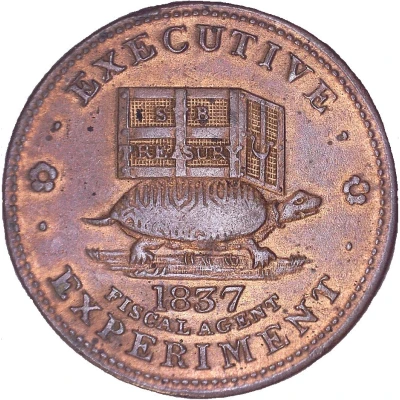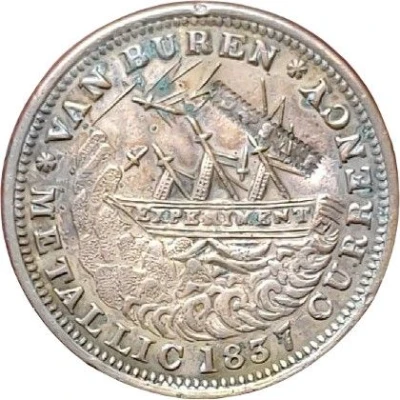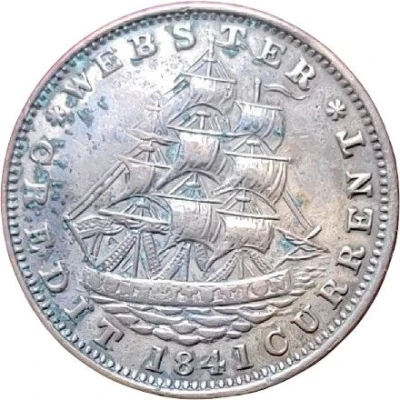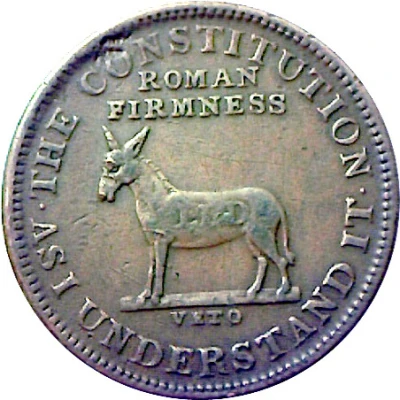


© Ringgy (CC BY)
1 Cent Executive Experiment
1837 year| Copper | 10.82 g | 28.5 mm |
| Location | United States |
|---|---|
| Type | Medals › Advertising medallions |
| Year | 1837 |
| Value | 1 Cent (0.01) |
| Composition | Copper |
| Weight | 10.82 g |
| Diameter | 28.5 mm |
| Thickness | 2 mm |
| Shape | Round |
| Technique | Milled |
| Orientation | Coin alignment ↑↓ |
| Demonetized | Yes |
| Updated | 2024-11-12 |
| Numista | N#79270 |
|---|---|
| Rarity index | 73% |
Reverse
A running jackass to left. Lettering above and below, beaded border.
Script: Latin
Lettering: I FOLLOW IN THE STEPS OF MY ILLUSTRIOUS PREDECESSOR
Edge
Plain
Comment
The differences from HT #31 are -the position of the ear in relation to the first L (ILLUSTRIOUS),
the shape of the tail,
the relationship of the hooves to the ground, etc.
Additional note:
The end of the safe has the handle to the left of the vertical strap
A satirical and privately produced token from the time of the US financial crisis of 1837.
This is an ideological token without a head. The 'executive experiment' was Van Buren's sub-treasury idea using a fiscal agent. The tortoise carrying the safe meant the democrats could never get the Bill through Congress. On the reverse is a line from Van Buren's inaugural speech when he said "I follow in the steps of my illustrious predecessor." Contemporary cartoons showed Van Buren behind a Jackass stepping in its hoof prints!
The period between 1832-1844 was a turning point in the history of the United States and centred around the controversy over whether public funds should be kept in a privately controlled institution. President Andrew Jackson began the controversy by vetoing a Bill in 1832, to continue the existence of the private Bank of the United States, and it passed its charter expiration in 1836. An economic depression began in 1837 when even state banks proved to be unworthy places to keep the country’s funds. A whole category of collecting centres around the “Broken Bank Notes” of this period. Emotions ran high and as the economy worsened, the population hoarded gold and silver. Small transactions became difficult. The government hadn’t the capacity to supply copper coins to substitute for the hoarded money. Hundreds of large cent-size tokens began to appear to take the place of small silver coins. These tokens had advertising messages or political statements as their themes.
This is a Hard Times token (know as “Jackass running”) and is one of the first instances of the symbol of the “Democratic party” of Andrew Jackson. The issuer is critical of the policy of eliminating the Bank of the United States (I FOLLOW THE ILLUSTRIOUS STEPS OF MY PREDECESSOR). The obverse legend says: 1837 EXECUTIVE EXPERIMENT, and above FISCAL AGENT referring to the tortoise. On the tortoise’s back is a treasure chest, representing the funds of the United States, and on the chest is SUB TREASURY which refers to the independent “sub-treasury” system that the government established.
Probably the tortoise represented what the critics thought the government would make out of the economy; slow. The critics were nostalgic for the high-flying boom that was fuelled before 1832 by worthless paper money and overextended credit.
The hundreds of tokens produced became a communication and propaganda device, stimulating discussion about topics such as suffrage and slavery. The tokens might have contributed to the change from voting for president by state legislators, to the present system of direct vote.
The tokens were successful communicators and became the forerunners of campaign buttons and pins.



